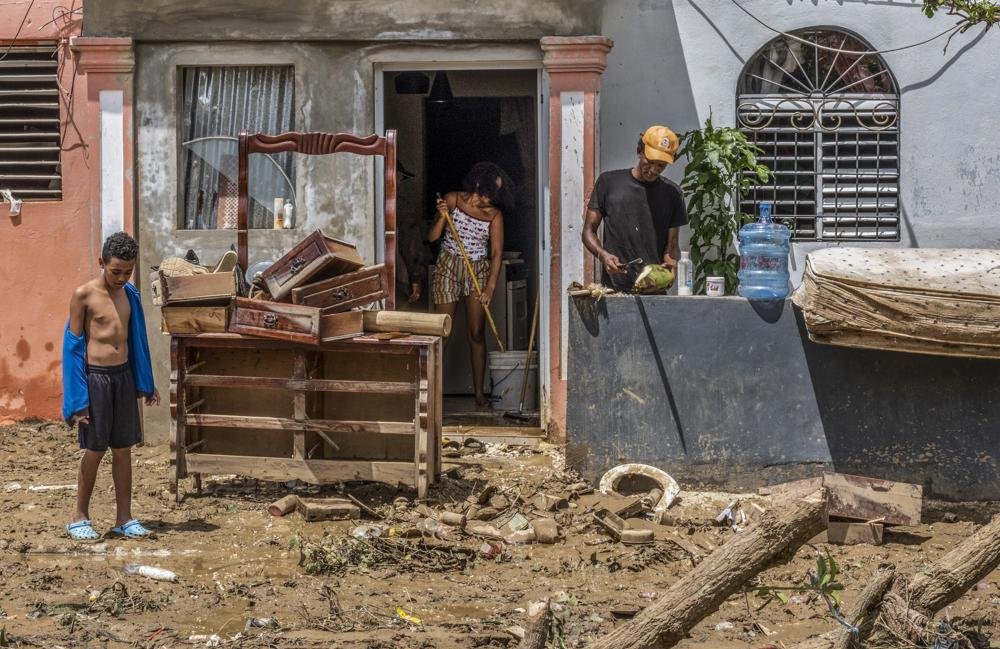U.S. Presents Aid to Puerto Rico After Hurricane Fiona Leaves Devastating Damage
Neighbors work to recover their belongings after the flooding caused by Hurricane Fiona in the Los Sotos neighborhood of Higüey, Dominican Republic, Tuesday, Sept. 20, 2022. (AP Photo/Ricardo Hernandez)
Historic storm Fiona left a widespread trail of damage throughout the Caribbean, leaving immense infrastructural damage, downed trees, catastrophic flooding, and power outages in its path. Fiona is the first hurricane to hit Puerto Rico since Hurricane Maria struck the island 5 years ago, destroying the island’s power grid and leaving 3,000 dead.
“We thought we had a bad experience with Maria, but this was worse,” Gerardo Rodríguez told WIS News.
The storm struck the southwestern coast of Puerto Rico as a Category 1 on September 18. The island received up to 103-mph wind speeds, leaving more than 1 million without power. The island experienced 30 inches of rainfall, leading to destructive flood levels and mudslides, inhibiting Puerto Ricans from accessing roadways and bridges. Residents are still stranded without electricity and medical aid, as medical personnel are making efforts to reach regions of the island. According to Puerto Rico’s Department of Health, 13 deaths have been confirmed in direct relation to the storm and more deaths are under investigation.
Although two weeks have passed since Fiona struck Puerto Rico, around 100,000 residents in the western and southern sides of the island are still awaiting the return of their electricity, according to LUMA Energy, the company that supplies the island’s power.
President Biden made a statement addressing the damage from Fiona. “I am committed to you and the recovery of the island. We’ll stand by you for however long it takes to get it done,” Biden said at the FEMA briefing.
In November of 2021, Biden signed a $1 trillion bipartisan infrastructure law, which will go towards roads, bridges, and ports. After visiting Puerto Rico in the wake of Fiona’s damage, President Biden announced that his administration will provide $60 million, via the infrastructure law, to rejuvenate Puerto Rican shore levees, flood walls and create a new flood warning system. These upgrades will strive to ensure that the island will be better prepared for future storms.
However, residents remain skeptical of the U.S. aid that is being adamantly promised. Hurricane Fiona is one of many disasters that have struck Puerto Rico and many believe that Biden’s promises will be fleeting.
Survey conducted Sept. 23-25, 2022, among a representative sample of 2,005 registered voters, with an unweighted margin of error of +/-2 percentage points (Morning Consult and Politico, 2022)
The Puerto Rican people are skeptical of the Biden administration’s aid as a reaction to the Trump administration’s withdrawal of aid to Puerto Rico. Trump drew back the funding to Puerto Rico on the basis of “mismanagement” in 2018. After these events unfolded, many believed that there would be no hope for Puerto Rico to receive adequate funding from the U.S.
There is currently an estimated $3 million in damage to the island and the costs will likely increase as conditions are fully evaluated. A Morning Consult and Politico poll found that 3 in 4 registered U.S. voters believe that the U.S. government should carry the financial responsibility of reviving Puerto Rico after the damage Fiona has left on the territory
With Puerto Rico still recovering from the damages from Hurricane Maria and the compounding damage done by Fiona, storm-resistant infrastructure is essential to preserving the island’s livelihood. The possibility of “carrot and stick” aid from the U.S. government should be eradicated as the need for rehabilitation in Puerto Rico outweighs any political differences among U.S. voters. The relationship between Puerto Rico and the U.S. has been historically complicated. The territory has limited autonomous jurisdiction but still lacks any significant representation in Washington D.C. Federal tax relief and aid have been slowly peeled away from the territory’s government. Puerto Rico proposed a recovery plan to negotiate lower debt payments, but the U.S. Supreme Court rejected the law. The U.S. has left Puerto Rico at the mercy of their aid and there is an urgent need for reform. The survey of U.S. voters depicts the consensus to provide for Puerto Rico’s population with the financial assets to rebuild their infrastructure and secure a stable future for the territory.


